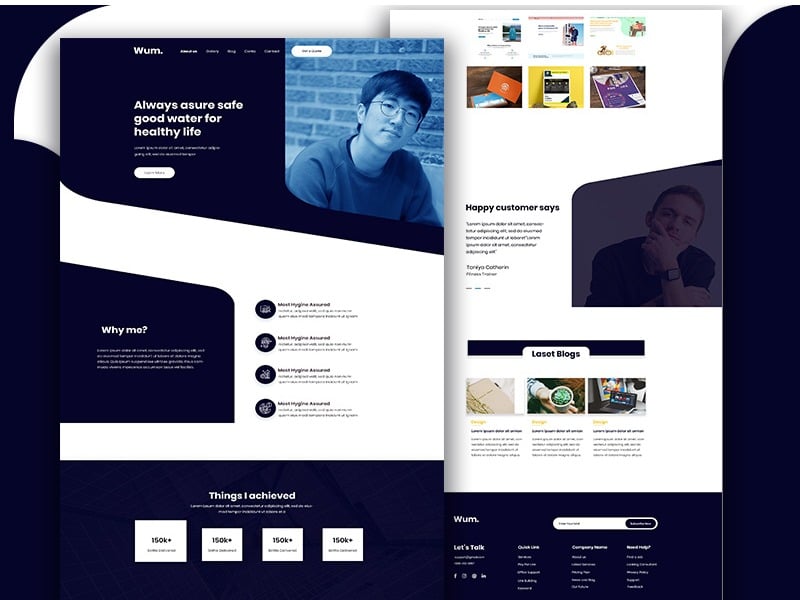Free UX Design Course
Dive into UX design with our free starter course. Transform your creative ideas into user-friendly solutions.
Arguably the most important asset a UX designer can have is empathy: the ability to understand and share the feelings, perspectives, and experiences of another person.
To successfully design something that solves users’ problems and meets their needs, UX professionals must be able to get out of their own heads, interact with a cross-section of users, empathize with them, and apply what they’ve shared to the product development process.
Because of that focus on sharing information and learnings, UX designers tend to help each other out: passing along tips, suggesting new tools to use, and imparting lessons learned throughout their careers (see here how to become a UX designer).
Mentor-guided learning is at the heart of the Springboard experience. We’ve seen how valuable it is for students to have one-on-one conversations with an industry expert who can share real-world insights about the day-to-day of a UX practitioner.
Related: What is UX Design?
So for our new ebook on UX lessons learned, we turned to our mentor community, along with alumni and other authorities, to find out what they wish they had known earlier in their UX journeys.
True to form, they were delighted to share.
Ana Santos
UX Consultant | @ux_by_ana

Ana Santos is a Portugal-based UX designer and conversion rate optimization consultant who primarily works with fashion, lifestyle, and personal brands. She believes that “we can change the web for better, one user-centered experience at a time.” Since the spring of 2018, she’s also mentored Springboard’s UX design students. Here’s one of the lessons she shares with her mentees.
Lesson: Get the Team on Board
Through my years working in different UX roles with different-sized companies at different levels of UX maturity, one thing I learned was the importance of getting your team and stakeholders involved as early as possible in the process.
Even when you’re a solo UXer and a UX team of one, it’s still important to get everyone on board and advocate for user-centered design. From C-level decision-makers to all other members involved in the project (development, project management, copywriters), everyone should learn how to focus on the end user and have a say on how to solve their problems.
Building a user-centered culture can start with anyone in the company, and ultimately, needs the buy-in from the whole team involved in the project. In order to do this, here are a few things to consider:
- Empathy: Put the users in front of everyone! Personas and empathy maps are one way to deeply understand user needs and remind everyone of those on a daily basis.
- Alignment: For the entire team to be involved throughout the process, it’s important that the research findings are shared and discussed together. The users and their pain points need to be considered when making any decisions.
- Iteration: Anything that is developed from scratch will be an assumption. It’s essential to keep iterating to understand the users and their needs while they evolve. If a test fails, test again.
Andre Martins
Product Design and Management Consultant | @andretweeting

Andre Martins has over 12 years of experience making digital products. He spent more than four years at Disney and founded two startups. He currently consults for both startups and Fortune 100 companies, including Walmart and Unilever. He has mentored more than 250 UX designers and product managers during what he describes as a “rewarding journey” of giving back. Here’s one of the lessons he has learned along the way.
Lesson: Feedback Is King
One of the most important skills people miss is learning to give and receive feedback. It might sound easy, but most people don’t know how to do either. It took me a while to learn it during the early part of my career, but it is one of the critical factors for my achievements.
Here are some key points that helped me improve:
Get To Know Other Design Students
Jane French
Founder at Ella Verbs
Diego Encarnacion
Design Researcher And UX Designer at IBM
Valena Del Valle
Junior Product Designer at The Hartford
When I receive feedback:
- I listen, but I don’t react. I only speak for two reasons: to clarify the points presented or to ask questions and learn.
- I hold my initial reaction if presented with something I disagree with. These are gold. The trick is to digest the feedback and reflect on it later to see if it makes sense.
- I’m grateful. I thank the person, no matter how negative the feedback was. They’re trying to help.
- If possible, I go for volume. Different backgrounds make feedback richer. I love discovering conflicting feedback. It helps me understand how complex a subject can be.
When I give feedback:
- I’m honest and transparent. I clarify that I’m objective, so the process is efficient.
- I’m kind. This person invested energy and dedication. Nothing is bad. Ever. For me, there are only things that are good and things that can be improved.
- I present specific points and expand. I show the opportunity for improvement and draw an attractive positive future. I state the risks and consequences of the decisions.
Feedback applies to everyone, from an intern to the CEO. By discussing it together and sharing different perspectives, we build a better understanding of reality. The sooner we face reality, the faster we evolve.
Catherine Hicks
User Experience Consultant | @catherinebhicks

Catherine Hicks began her career two decades ago as a front-end developer. Her focus eventually shifted to visual design and UX. She’s worked for startups and giant tech companies on projects ranging from logo design to full-blown marketing and collateral presentations to user research. Needless to say, she’s learned a lot. But, as she points out here, she doesn’t know everything.
Lesson: You Don’t Know What You Don’t Know
The biggest lesson I had to learn early in my career is that “I don’t know” is a perfectly acceptable answer. It’s actually a great answer to have when working in the field of user experience because it allows you to learn from your users’ perspectives.
Particularly when coming into a new role, we are often our own worst enemies, trying so hard to impress that we tend to back ourselves into corners by overstating our knowledge because we don’t want to be seen as dumb or not knowledgeable in our field.
However, when you state that you don’t know something, you open yourself up to the opportunity to learn something new and learn it without shame. It allows you to open new avenues of exploration that you may miss if you pretend to know everything.
My greatest learnings have followed the statement “I don’t know.” It’s something I will always tell students is one of their greatest assets.
Débora Edelberg
Lead UX Designer | @deboraedelberg

Débora Edelberg has more than 10 years of experience designing multi-platform digital products using user-centered design principles. She has worked for several industries, including aerospace, banking, and e-commerce. In addition to her work, she has mentored Springboard’s UX design students since the summer of 2018.
Lesson: Be Open to Criticism
We are not designing for ourselves. This means it’s very important to show what we design to other designers, developers, and of course, potential or real users. Making a good experience for a product is a multidisciplinary effort, so It’s very important to hear the vision of team members in other roles. For example, a developer will know if what you are designing is technically feasible. Additionally, you are designing for users who will be, in most cases, very different from you, so what works for you might not work for them. That’s why it’s so important to have them test the product and share their feedback.
Here are a few tips for receiving feedback:
- Listen actively: Avoid interrupting the person who’s giving the feedback. Hear them out. They’ve taken time to look through your work and they deserve respect.
- Seek feedback early in the process: This will allow you to be less attached to the work, since you didn’t spend too much time on it. Also, try to seek feedback regularly throughout the entire design process.
- Avoid being defensive: Critical feedback is an opportunity to see your work from a different perspective and learn from it. Try not to take it as an attack on you as a designer. It’s OK to explain your approach, but if you act defensively it will make the critiquer avoid further discussions.
In brief, enjoy the process of learning and remember that you’re trying to solve a business problem. It’s not about you, but about how well the problem is being solved.
Andrea Soverini
UX and Product Designer | @sovesove

Andrea Soverini began his career as an interaction developer on a fast-paced agile team of three, and then quickly found himself leading other developers on what became a 30-person cross-functional team. When coding became unsatisfying, he moved into user experience to tackle “harder questions that could only be answered using psychology, instinct, and data.”
Lesson: The UX of Selling UX
Both for in-house and agency dynamics, something that took me a long time to embed in my design process is the best way to get a whole team (or client) to back a design solution or roadmap. Sometimes the marketing team has its own goals: maybe the client wants to increase conversions—you name it. There is always a reason to push back on what is best for the users.
How to avoid this:
- Collaboration: From the earliest stage of a project, involve key stakeholders and any other team members who will be involved. This will help you come up with more solid solutions and make everyone feel ownership of the design choices.
- Rationale: Even when you collaborate, you will have to make decisions that not everyone will agree with. Be sure to make clear what the rationale behind your decision is and try to anticipate questions from your stakeholders.
- Business case: Especially when the design maturity of a company or a client is not great, it’s important to support your ideas with a business case that justifies your decisions. This will help you get buy-in from key stakeholders.
- Speak up: Don’t be afraid to walk in the room and make clear what your role is. You’ve been hired to be the user’s voice, so when something goes in the wrong direction, make sure you clearly state that you are not able to support that decision. This will help for future benchmarks on how to make decisions and prioritize design tasks.
These are just five of the 21 lessons shared in our new ebook. You can download the entire collection of UX lessons learned for free here.
Since you’re here…
Interested in a career in UX design? Rise to the top of the CV pile when you enroll in our UX Bootcamp—you’ll get a UX job or your tuition money back. Take a look at our student reviews and test out our free UX course to get a feel for our style and results. TL;DR: average starting salaries for our students = $85,440. Let’s do this.






